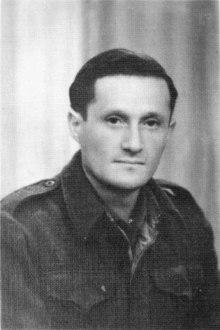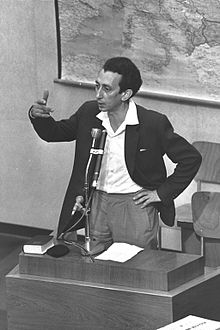Nakam

Nakam ( he : Vengeance ; actually Dam Yehudi Nakam , in German about The Jewish blood will be avenged ) was a Jewish organization that had set itself the goal of taking revenge for the Holocaust and showing the world that the Jews were there since 1945 be able to fight back and retaliate. Its core was a group of Ukrainian Jewish partisans, including Pascha Reichman (later Jitzchak Avidov ). Their leader was Abba Kovner , who was 27 at the end of the war , a poet and resistance fighter who was involved in the uprising in the Vilna ghettoand had fought against the Germans as the commander of the Fareinigte Partisaner Organization .
The Nakam was significantly more radical than the Jewish Brigade . In contrast to this, the Nakam directed its acts of revenge not primarily against the war criminals, but against the entire German people. The Nakam men saw a collective guilt of the German people for the murder of Jews and therefore planned to take revenge and kill an equal number of Germans. Two plans were pursued, poison appeared to be the appropriate weapon for this: Plan A provided for the poisoning of drinking water supplies in Hamburg , Frankfurt am Main , Munich and Nuremberg , and Plan B for the mass murder of SS members in Allied POW camps .
Plan A
Plan A failed in preparation, although Reichman had succeeded in smuggling members of the Nakam into the waterworks in Nuremberg and Hamburg . Kovner traveled end of July 1945 for the procurement of the Gifts for Plan A to Palestine . According to his own statements, Chaim Weizmann , the future President of Israel, a chemist by profession, helped him with the procurement by referring him to Ernst David Bergmann , who provided the poison, as well as to a sponsor for the campaign. Kovner's later report is doubted by the historian Tom Segev (1991) because Weizmann was not in Palestine at the time. It is also not clear what kind of revenge Kovner described to the interlocutor in Palestine; according to Sarid, Weizmann was only informed about Plan B. He also met with skepticism and resistance.
In December 1945, Kovner returned to Europe on a British ship , with the support of the Hagana in the uniform of the Jewish Brigade and with the appropriate papers. He had the poison hidden in 20 cans of milk with him and was accompanied by three members of the Hagana. Shortly before entering the port of Toulon he was called out. Before his subsequent arrest, he threw some of the poison into the sea, the rest was disposed of by his companion from the Hagana in a similar way. Kovner was then held in a military prison in Cairo for about four months without being charged with or even questioned for an attempted attack. Who was responsible for his arrest could not be determined.
Plan B
After Kovner's arrest, his deputy Reichman tried to implement Plan B with his men. In Paris he got 20 kg of arsenic. Even before the attack in Nuremberg, of which Joseph Harmatz was the commanding officer, Reichman had to call off a similar action that was planned for the Dachau prison camp to the displeasure of the command there. On April 13, 1946, members of the group broke into the Nuremberg consumer bakery on Schleifweg , which supplied the internment camp in Langwasser (formerly Stalag XIII D), which at that time contained around 12,000 to 15,000 prisoners of war, mainly members of the SS . 3000 of the loaves of gray bread stored there were brushed with water into which arsenic powder was stirred. The bread was delivered on April 14, 1946 and numerous camp inmates became seriously ill. American newspapers printed agency reports in which the number of sick people in the first report was 1900, a few days later in a second report 2283. The Süddeutsche Zeitung reported on April 24, 1995, the Nürnberger Nachrichten on April 27 of illnesses. The command groups in Germany fled to Prague and got on a ship to Palestine on June 18, the Paris group embarked on June 22 in Marseille.
It remained unclear whether there were fatalities in the attack and how severe the illnesses were. In 1999, as part of an investigation by the Nuremberg Public Prosecutor's Office, the Nuremberg judicial press spokesman Ewald Behrschmidt stated that all the documents “clearly show that no one was killed at the time”. In 1999, two former prisoners from the Waffen-SS who were affected reported to the Nürnberger Nachrichten that many comrades and they themselves were seriously ill, some even went blind for several days and later regained their eyesight, but to their knowledge no one had perished. Kovner had only vague information later on, and it was difficult for him to admit that the operation had failed. Even decades later, individual Nakam activists regretted the failure.
In 2018 and 2019, over 300 human bones were found during construction work to erect a noise protection wall along a federal road in the south of Nuremberg . It was quickly speculated whether this was a mass grave of former SS and NSDAP members who were imprisoned in a nearby internment camp in Nuremberg-Langwasser after 1945. The bones found - so the speculation - could be victims of the arsenic attack by the Nakam who were buried here in a mass grave. In order to clarify this, the bones were sent to Miami (USA) for a closer examination . The result of the investigation brought clarity: the bones are between 559 and 600 years old, so that they cannot be poisoning victims of the Nakam. In the opinion of the city archaeologist in Nuremberg, the bones are in all probability a former cemetery of the Heilig-Geist-Spital , which used the rediscovered site as a cemetery until 1525 .
Investigations
In May 2000, the public prosecutor at the Nuremberg Higher Regional Court closed an investigation into attempted murder against two Nakam activists who had confessed to the crime. The public prosecutor's office cited "Statute of limitations due to extraordinary circumstances" as the reason for this.
memory
Kovner and Avidov gave interviews in the 1980s that were recorded at the Hebrew University of Jerusalem and the Moretschef Archives. The Nakam story was passed on from Kovner to Levi Arieh Sarid before his death in 1987, who in 1992 created a manuscript Revenge: History, Appearance and Implementation , which remained unpublished. Sarid had also asked Reichman / Avidov about this. This manuscript could be viewed in a translation by Tobias / Zinke. Tobias and Zinke also conducted interviews with Oleg Hirsch (pseudonym), Leipke Zinkel and Joseph Harmatz who were involved in the attack in Nuremberg. Colportage-like representations were also published about the attack, in which other versions of the poisoning attack were distributed without citing the source.
reception
literature
- Tom Segev : The Seventh Million. The Holocaust and Israel's Politics of Remembrance . Rowohlt Verlag, Reinbek 1995, ISBN 3-498-06244-1 , p. 192-208 (first Hebrew 1991).
- Jim G. Tobias, Peter Zinke: Nakam. Jewish revenge on Nazi perpetrators . 1st edition. Konkret Literaturverlag, Hamburg 1995, ISBN 3-89458-194-8 .
- Joseph Harmatz: From the wings. Book Guild, Lewes 1998, ISBN 1-85776-340-8 . (Autobiography)
- Eike Geisel : The end of the closed season. In: concrete . Issue 5/1995. The same article in: Eike Geisel (author); Klaus Bittermann (ed.): Triumph of good will. Berlin 1998, ISBN 3-89320-013-4 ( adf-berlin.net ).
- Avi Avidov: Attempts at Revenge. In: Jewish Resistance in the Holocaust. ( antinaziresistance.org , English).
- John Kantara : The war was over, Dov Shenkal and his friends had only one goal: retaliation for the mass murder of the Jews. They looked for the guilty party on their own - and killed them. A visit to three men who have no regrets. In: The time . December 5, 1997. zeit.de , on Pascha Reichmann pp. 3 and 4. The same article with a different title: The Avengers - how Jews killed Nazis. kantara.de .
- Christoph Gunkel: The real Nazi hunters. at Spiegel Online. (based on Tobias / Zinke)
- Jonathan Freedland: Revenge. In: The Guardian . July 26, 2008.
Movie
- Doron Paz, Yoav Paz: Plan A . Israel / Germany. 2020.
Web links
- Andrea Übelhack: "Nakam". Jewish revenge on Nazi perpetrators. , at hagalil.com
- "The Avengers" - Jewish retaliatory actions in Nuremberg. Medienwerkstatt Franken at vimeo.com (film documentation)
Individual evidence
- ↑ a b Jim G. Tobias, Peter Zinke: Nakam. Hamburg 1995, p. 32.
- ↑ Jim G. Tobias, Peter Zinke: Nakam. Hamburg 1995, p. 28.
- ↑ a b c d Tom Segev: The Seventh Million. Reinbek 1995, pp. 192-200.
- ↑ Tom Segev has viewed statements by Kovner and Avidov that are in the Hebrew University of Jerusalem and in the Moretschef archive. See Tom Segev: The Seventh Million . Reinbek 1995, p. 703.
- ↑ Tom Segev: The Seventh Million. Reinbek 1995, p. 197.
- ↑ Jim G. Tobias, Peter Zinke: Nakam. Hamburg 1995, p. 34.
- ↑ Jim G. Tobias, Peter Zinke: Nakam. Hamburg 1995, p. 29 f.
- ↑ Jim G. Tobias, Peter Zinke: Nakam. Hamburg 1995, p. 33.
- ↑ Jim G. Tobias, Peter Zinke: Nakam . Hamburg 1995, p. 44; Tom Segev: The Seventh Million . Reinbek 1995, p. 199, p. 200, p. 704.
- ↑ Jim G. Tobias, Peter Zinke: Nakam . Hamburg 1995, p. 40.
- ↑ Jim G. Tobias, Peter Zinke: Nakam . Hamburg 1995, p. 20. Other variants of bread poisoning are also rumored. In Segev, p. 199, the burglars scattered the arsenic in the dough. According to Tobias / Zinke, there was white bread for the security guards on Sunday, April 14th.
- ↑ 1900 Prisoners Are Poisoned . In: San Jose News . April 19, 1946, p. 1 (English, [1] [accessed December 27, 2012]).
- ↑ Poison Bread Fells 1,900 German Captives in US Prison Camp Near Nuremberg . In: The New York Times . April 20, 1946, p. 6 (English, summary [accessed December 27, 2012]).
- ↑ 2,283 Poisoned In Plot Against SS Prisoners . In: Miami Daily News . April 22, 1946, p. 1 (English, [2] [accessed December 27, 2012]).
- ↑ Poison Plot Toll of Nazis at 2,283 . In: The New York Times . April 23, 1946, p. 9 (English, summary [accessed December 27, 2012]).
- ↑ Jim G. Tobias, Peter Zinke: Nakam. Hamburg 1995, p. 51.
- ↑ Elizabeth Jändl: "Nakam" -Attentat in stock: NN readers remember. Eyewitnesses from Langwasser and Auerbach: "As far as I know, nobody died". Nürnberger Nachrichten , November 5, 1999.
- ↑ Jim G. Tobias, Peter Zinke: Nakam. Hamburg 1995, p. 55.
- ↑ Hartmut Voigt: Secret of the skeleton finds on the southwest bypass revealed. In: nordbayern.de from July 28, 2020 - available online
- ↑ court. Jewish poisoning attack on Nuremberg Nazi camp is barred. Thousands of loaves of bread coated with arsenic. Judges recognized the personal fate of the perpetrators as mitigating guilt . In: WAZ . May 9, 2000.
- ↑ Jim G. Tobias, Peter Zinke: Nakam. Hamburg 1995, pp. 144-153.
- ↑ Tobias / Zinke name Michael Elkins and Janusz Piekałkiewicz .

